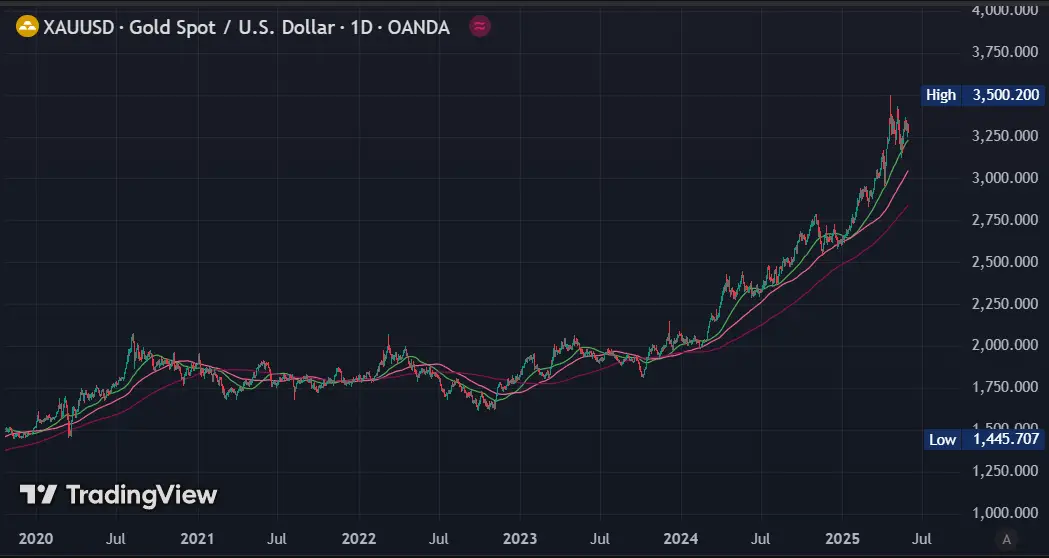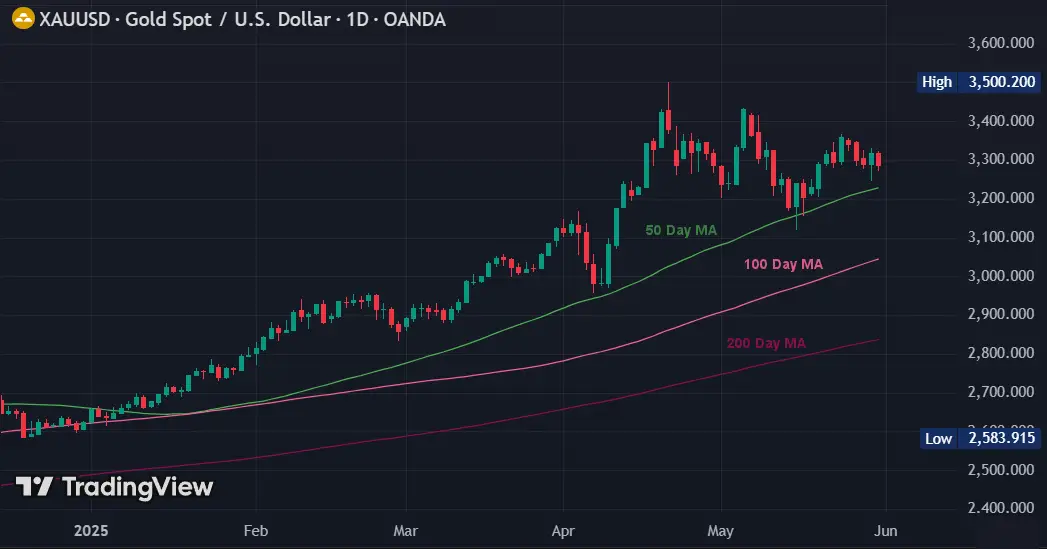For thousands of years, gold (and to a lesser extent silver) have been mediums of exchange and methods of preserving wealth over time.
Throughout 2024 and 2025, gold prices have been surging, driven by a combination of central bank buying, shifts away from U.S. dollar dominance, and a fear of financial exclusion, i.e., “debanking”.
Let’s examine why gold is surging, the evolving narrative surrounding gold, Central Banks, and cryptocurrencies.
Record-Breaking Price Momentum
According to the World Gold Council, during the first quarter of 2025, the London PM price of gold averaged US$ $2,860 per ounce, representing a 38 percent annual increase and setting new quarterly records. On May 30, 2025, gold was $3,310 in New York, down from the $3,500 peak on April 22nd.
The primary drivers have been geopolitical uncertainty, including the U.S.–China tariff dispute, the Russia-Ukraine war, Iran, and even an India-Pakistan skirmish. Which have all amplified risk premiums on equities and fueled demand for safe-haven assets. Also, increased inflationary expectations and dovish U.S. Federal Reserve signals have weakened the dollar index, further propelling gold’s dollar-denominated price upward.
Central Bank Accumulation
Central banks have been the primary buyers of gold in recent years, and their appetite remains robust in 2025. Official central bank gold demand topped 1,000 tonnes for the third year in a row in 2024. Compared to central bank gold reserves which increased by only about 473 tonnes per year from 2010 to 2021.
According to Advisor Perspectives, official net purchases totaled 244 tonnes in the first quarter of 2025. Although this was below the Q1 2024 peak of 310 tonnes, it is still 25 percent above the five-year quarterly average, indicating continued strategic accumulation by Central Banks. Surprisingly, the National Bank of Poland was the largest buyer, accelerating its buying pace, while emerging market institutions from Azerbaijan to Thailand maintained consistent purchases1. Instead of relying on U.S. Treasuries (which carry political and credit risks), Central Banks are shifting more of their reserves into gold, a physical asset that doesn’t depend on anyone’s promise to pay.
The Rise of De-Dollarization
“De-dollarization” might sound like a buzzword, but it’s a real trend. Countries are retreating from the U.S. dollar’s hegemony and looking for alternative exchange options. They are also reducing dollar-denominated bond and treasury holdings and boosting gold reserves.
Why? In part to sidestep potential U.S. sanctions, and in part to guard against dollar volatility. For nations in the BRICS bloc (Brazil, Russia, India, China, South Africa) this makes a lot of sense. By adding gold and other currencies into the mix, they’re effectively saying, “We don’t need the dollar to get by.” This trend not only underpins gold’s price rally but also challenges the dollar’s traditional role as the world’s primary reserve currency.
Debanking: When Banks Shun You
Recently, there have been headlines about companies—or even individuals—getting “debanked,” meaning their bank decides to close their accounts or refuses to offer services. Under the Biden administration, political opponents, crypto firms, and gun stores felt this squeeze particularly hard, since banks labeled them “high risk.” For investors uneasy about bank service denial, gold (and increasingly Bitcoin) offers a non-custodial store of value beyond the banking system.
Bitcoin’s “Digital Gold” Narrative
As gold’s narrative strengthens, Bitcoin proponents have increasingly positioned BTC as “digital gold”—a scarce, decentralized asset capable of preserving purchasing power in an inflationary environment. Prior to 2018, Bitcoin was considered a speculative, high-risk asset. From there, it moved to the “risk-on” asset category, highly correlated to the NASDAQ. A study analyzing data from 2018 to 2025 found that correlation levels intensified following key institutional milestones, with peaks reaching 87% in 2024. Yahoo Finance
But recently, BTC has also begun showing some “risk-off” (i.e., safe-haven) properties as well. According to CoinDesk there has been a 70% correlation between Bitcoin prices and gold over the last year, underscoring their shared safe-haven appeal and diversification potential. And during the April Trump Tariff scare, BTC decoupled from the declining NASDAQ and actually rose.
A 19th-Century Precedent: The Rothschilds and Government Debt
Prior to 1913, gold was money, but it was difficult to transport across borders, so the Rothschild banking family pioneered another form of asset transfer using government debt (basically creating a fiat currency).
In the early 1800s, Mayer Amschel Rothschild and his five sons built a Europe-spanning network that allowed them to buy and sell sovereign bonds across borders almost instantly. By leveraging price differentials between, say, British Consols and French rentes, they could move large sums of wealth from one country to another without physically transporting gold or coins.
Today, physical gold faces the same transportation issues. It is still heavy, difficult and time-consuming to transport, and suffers from large bid/ask spreads that can eat away at its profit potential. Bitcoin on the other hand, suffers none of these drawbacks. Perhaps if Amschel Rothschild were around today, he would be moving currencies via BTC.
Forecasts and Scenarios
Looking ahead, major financial institutions project continued upside for gold. From a technical standpoint, gold’s chart patterns reveal successive higher lows and throughout 2025 it has traded above its 50, 100, and 200-day moving averages.
Key Takeaways:
- Gold prices hit fresh highs in early 2025, thanks to geopolitical risks, inflation concerns, and a softer dollar.
- Central banks remain voracious buyers, using gold to balance and de-risk their reserves.
- De-dollarization efforts and debanking fears are boosting gold’s appeal.
- Bitcoin, while volatile, is carving out its own “digital gold” niche.
- Technical charts show a clear uptrend, but policy shifts (like Fed rate moves) can trigger short-term swings.
Footnotes:
1 Central Bank Gold Buying World Gold Council.



Leave a Reply